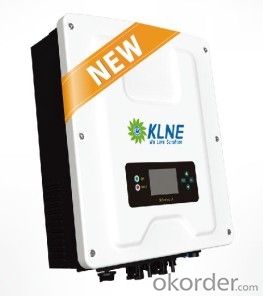Solartec D 4600 on grid inverter with 2 MPPT WIFI
- Loading Port:
- Shanghai
- Payment Terms:
- TT OR LC
- Min Order Qty:
- -
- Supply Capability:
- 10000 set/month
OKorder Service Pledge
Quality Product, Order Online Tracking, Timely Delivery
OKorder Financial Service
Credit Rating, Credit Services, Credit Purchasing
You Might Also Like
Solartec D 2500,3000,3600,4000,4600,5000
2MPPT Trackers
online monitoring system by integrated WIFI
Integrated DC Switch
Comprehensive protection functions
Graphic display
High efficiency 97.5%
RS 485/RS 232/SolarLog Communication
5 Years warranty
G83,G59,VDE 4105,VDE 0126,CEI





Beijing Kinglong New Energy Technology Co., Ltd.
3rd. floor, Caihong North Building West Entrance, 11 Xinxi Road, Shang Di, Haidian Dist, Beijing, China
T.:+86(0)1062988159-678 M.: +86 1800 1179 441
Skype:klnevivian
Skype:klnevivian
E:vivian@kinglongpower.com
Website: www.kinglongpower.com
- Q: How does a solar inverter handle voltage regulation in the grid?
- A solar inverter handles voltage regulation in the grid by constantly monitoring the voltage levels and adjusting its output accordingly. If the grid voltage is too high, the inverter reduces its output to prevent overloading and potential damage to connected devices. Conversely, if the grid voltage is too low, the inverter increases its output to compensate for the deficit and maintain a stable voltage supply. This regulation ensures that the solar energy generated by the inverter is seamlessly integrated into the grid while adhering to grid voltage standards.
- Q: Can a solar inverter be used in conjunction with a smart home system?
- Yes, a solar inverter can be used in conjunction with a smart home system. The smart home system can integrate with the solar inverter to monitor and control the energy production, consumption, and storage. This allows for better optimization of energy usage, remote monitoring, and automated control of various devices and appliances within the smart home.
- Q: What is the efficiency of a solar inverter?
- The efficiency of a solar inverter refers to its ability to convert the direct current (DC) generated by solar panels into alternating current (AC) for use in homes or businesses. It is typically expressed as a percentage and indicates how effectively the inverter can convert the solar energy into usable electricity. Higher efficiency means less energy loss during the conversion process, resulting in more efficient utilization of the solar power.
- Q: Can a solar inverter be used in mobile or portable solar systems?
- Yes, a solar inverter can be used in mobile or portable solar systems. Portable solar systems often include a solar panel, battery, and inverter to convert the DC (direct current) power generated by the solar panel into AC (alternating current) power that can be used to power various devices and appliances. The inverter helps ensure compatibility and usability of the generated solar power in these mobile or portable setups.
- Q: How does the weight of a solar inverter affect its installation process?
- The weight of a solar inverter can significantly impact its installation process. Heavier inverters may require additional support structures or mounting equipment to ensure proper installation and stability. They may also require more manpower and specialized equipment during the installation process. Conversely, lighter inverters may be easier to handle and install, potentially reducing installation time and effort. Therefore, the weight of a solar inverter is an important consideration that can influence the overall installation process.
- Q: Can a solar inverter be used with a ground-mounted solar array?
- Yes, a solar inverter can be used with a ground-mounted solar array. In fact, ground-mounted solar arrays are commonly used with solar inverters to convert the direct current (DC) generated by the solar panels into alternating current (AC) that can be used to power homes and buildings.
- Q: What certifications should I look for when choosing a solar inverter?
- When choosing a solar inverter, it is important to look for certifications such as IEC 62109 or UL 1741. These certifications ensure that the inverter meets necessary safety and performance standards. Additionally, certifications like ISO 9001 indicate that the manufacturer follows quality management systems.
- Q: What is the role of a DC-DC converter in a solar inverter?
- The role of a DC-DC converter in a solar inverter is to convert the direct current (DC) generated by the solar panels into the appropriate voltage and current levels required for the inverter to convert it into alternating current (AC) electricity. The DC-DC converter ensures efficient power transfer and enables the solar inverter to maximize the energy harvested from the solar panels. Additionally, it helps regulate the voltage levels and maintain the stability of the solar power system.
- Q: How does a solar inverter handle different temperature conditions?
- A solar inverter is designed to handle different temperature conditions by employing various thermal management techniques. It typically has built-in cooling systems such as fans or heat sinks to dissipate excess heat. Additionally, advanced inverters may employ temperature sensors to monitor the internal temperature and adjust their operations accordingly. These temperature compensation features allow the inverter to maintain optimal performance and efficiency across a wide range of temperature conditions.
- Q: Can a solar inverter be used with building-integrated photovoltaics (BIPV)?
- Yes, a solar inverter can be used with building-integrated photovoltaics (BIPV). The solar inverter is an essential component that converts the DC power generated by the BIPV system into AC power suitable for use in buildings. It ensures efficient utilization of the solar energy produced by the BIPV system and enables integration with the electrical grid or building's power system.
Send your message to us
Solartec D 4600 on grid inverter with 2 MPPT WIFI
- Loading Port:
- Shanghai
- Payment Terms:
- TT OR LC
- Min Order Qty:
- -
- Supply Capability:
- 10000 set/month
OKorder Service Pledge
Quality Product, Order Online Tracking, Timely Delivery
OKorder Financial Service
Credit Rating, Credit Services, Credit Purchasing
Similar products
Hot products
Hot Searches
Related keywords



















